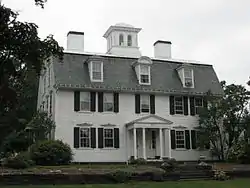The Manse (Northampton, Massachusetts)
The Manse is a historic church manse in Northampton, Massachusetts. With a construction history dating to 1744, it is in part a good example of vernacular mid-18th century architecture. It has also had a procession of locally notable owners and residents. The house was listed on the National Register of Historic Places in 1976.[1]
The Manse | |
 The Manse, 54 Prospect Street | |
  | |
| Location | 54 Prospect St., Northampton, Massachusetts |
|---|---|
| Coordinates | 42°19′20″N 72°38′12″W |
| Area | 1 acre (0.40 ha) |
| Built | 1744 |
| Architectural style | Georgian |
| NRHP reference No. | 76000263[1] |
| Added to NRHP | October 14, 1976 |
Description and history
The Manse is located in a residential area north of downtown Northampton, on the west side of Prospect Street at its junction with Trumbull Road. It is a two-story wood-frame structure, with a gambrel style roof and twin interior chimneys. Three dormers pierce the steep slope of the gambrel, the center one with a rounded arch roof, the outer two with hip roofs. A square cupola rises at the center of the roof. A 2+1⁄2-story ell, the oldest part of the building, extends to the rear.[2]
The property's history begins in the 17th century, when it was part of a land grant to Reverend Solomon Stoddard, whose parsonage was built here in 1684. Stoddard was the pastor of the first church in Northampton and the grandfather of Jonathan Edwards, a leading force in the First Great Awakening who briefly lived in that house. In 1744, Stoddard's son John built what is now the rear ell as a replacement for that house. John Stoddard was active in a civic affairs, serving in the provincial militia and the provincial legislature. His son, also named Solomon, built the front portion of the house in 1782; he served as sheriff of Hampshire County.[2] Other notable residents include Josiah G. Holland, writer and founder of Scribner's Monthly, and Dr. Benjamin Barrett, a prominent local politician.[3] The house was purchased in 1940 by Dorothy Douglas, a professor at Smith College, who oversaw its restoration. She also commissioned a series of murals that now adorn its walls; these were executed by Oliver Larkin.[2]
References
- "National Register Information System". National Register of Historic Places. National Park Service. April 15, 2008.
- "NRHP nomination for The Manse". National Archive. Retrieved 2018-04-14.
- "MACRIS inventory record for The Manse". Commonwealth of Massachusetts. Retrieved 2013-12-18.
